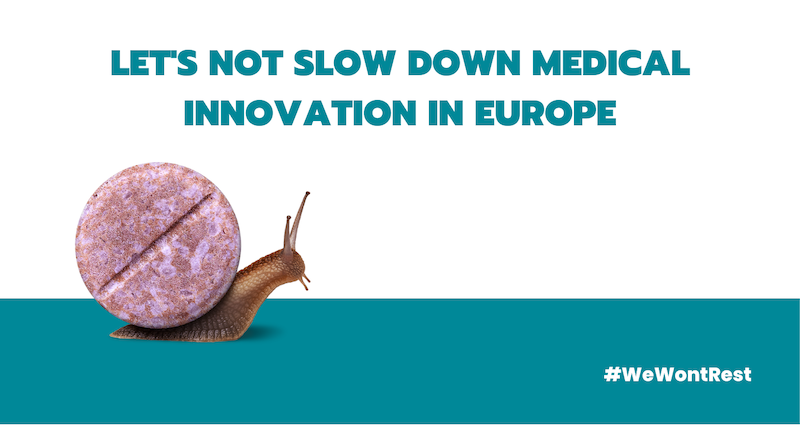
Rethinking the EU general pharmaceutical legislation for a competitive, more resilient and healthier Europe
As discussions surrounding the revision of the EU pharmaceutical legislation take place, two fundamental questions come to the forefront: how to ensure equitable access to medicines for all Europeans and how to foster a highly competitive and innovative pharmaceutical industry. I am concerned that the current draft legislation does not adequately address either of these objectives.
Tackling barriers to access
Achieving faster and more equitable access to medicines is as fundamental as it is challenging. One contribution to this that can be achieved at EU level is by streamlining regulatory decision-making processes which will lead to expedited approvals of new medicines for European patients.
For the rest, from analyses published over time, we note that delays predominantly occur during the pricing and reimbursement phase within Member States, necessitating collective action from various stakeholders. Competencies influencing access therefore reside firmly at country level, rather than within EU legislation. The attempt made in this reform to retrofit national access frameworks into EU legislation primarily designed to determine product approval and support innovation will not work.
Acknowledging the urgent need to improve access, EFPIA has taken concrete measures. These actions include a commitment to file for pricing and reimbursement in all Member States within two years of EU approval linked to a dedicated portal and regular reporting of that commitment to track progress. Additionally, EFPIA proposes that the adoption of novel pricing mechanisms and the introduction of tiered pricing based on ability to pay, can empower Member States to effectively introduce and finance new medicines. Implementing these measures as a comprehensive package can result in timely improvements in patient access to medicines, without compromising competitiveness or Member States’ health competence. Our modelling predicts an improvement of up to 64% in medicines access and reduction of delays for European patients up to five months. Establishing a multistakeholder group involving industry, patients, payers, and providers to address access barriers in the present, rather than waiting for the revised legislation to be agreed upon, should be prioritised by the Commission and Member States.
Safeguarding Europe’s competitive edge
At a critical time for Europe, a resilient and globally competitive pharmaceutical sector is essential to ensure the long-term health of Europeans as well as the region’s strategic autonomy and a thriving economy. However, over the past 20 years, Europe has witnessed a continuous decline in its global competitiveness, particularly in terms of research and development (R&D) investment. This decline has resulted in a significant loss of ground to regions such as the United States and China in medical innovation, a trend that is deeply concerning and requires immediate attention. It is crucial to address this ever-increasing gap and ensure that Europe’s 20-year-old regulatory framework becomes more agile, streamlined, and responsive to the rapidly evolving pharmaceutical landscape. In order to close the gap and stimulate further investment in the region, it is key to provide more attractive conditions than existing ones. The revision of the legislation gives us the opportunity to do just that and yet, instead of improving the conditions we propose to worsen them. I am particularly concerned about Europe’s intention to go in the opposite direction to its competitor regions when it comes to incentives for innovation. The draft proposals suggest reducing regulatory data protection and orphan market exclusivity. These proposed reductions, coupled with the introduction of conditions that hinder innovators’ ability to recover incentives, cannot be considered ingredients to improve the investment environment for life sciences in Europe. They will contribute to worsening existing negative trends, such as the 25% decline in European R&D investment and the reduction in
Europe’s global share of clinical trials from 25% to 19%. The recently released EFPIA annual figures, show that China’s R&D spending growth between 2018 and 2022 exceeded Europe’s by more than three times, underscoring the urgent need to for action to close the gap.
To tackle antimicrobial resistance, the draft legislation proposes to improve the investment environment by introducing better conditions. Here provisions aimed at reinvigorating antimicrobial R&D include a transferable exclusivity voucher scheme. While this demonstrates a commendable effort to support research in a critical area, the system as it is drafted today will not reach its aims due to the excessively stringent conditions attached to the incentive. To effectively promote antimicrobial R&D, it is necessary to strike a balance between encouraging innovation and providing realistic conditions for companies to engage in R&D activities. In addition to the detrimental effects that the revision of the pharmaceutical legislation in its current form could have, and in a context where Europe and Member States are focused on how to strengthen the region’s strategic autonomy, we see other policies being developed that could further negatively impact our competitiveness and increase dependency on other regions. A ban on PFAS materials – widely used in pharmaceuticals, manufacturing facilities and packaging – could be in place by 2027. This could reduce manufacturing capability in Europe, leading to shortages in the EU and globally and could see manufacturing move to other parts of the world.
Enhancing the pharmaceutical legislation for patient-centric innovation in Europe
› To effectively serve patient needs and fulfill the core purpose of Europe’s pharmaceutical legislation, I believe that a series of actions must be undertaken now › As proposed in the draft legislation, it is imperative to further enhance the regulatory framework to ensure a robust and efficient system. This involves maximising the use of expedited pathways, such as accelerated approval and priority review, to improve the availability of innovative treatments that cater to patient needs effectively. By optimising regulatory decision-making processes and reducing unnecessary administrative burdens, Europe can significantly improve access to life-saving therapies.
› In line with June 2023 European Council Conclusions, a critical step will be to strengthen, rather than reduce, the region’s incentives for innovation such as regulatory data protection and orphan drug market exclusivity. Adequate levels of incentives are essential to attract more investment in R&D activities in Europe, start to stop the declining trend and hopefully even reverse it, to close the gap. Creating separate conditions that specifically target unique challenges in healthcare can further drive innovation and ensure that the evolving needs of European patients are effectively addressed.
› Addressing barriers and reducing delays in accessing new treatments necessitates a collaborative approach based on a shared understanding of evidence. The recently published Industry European Access Hurdles Portal offers valuable insights into the various access challenges faced by patients, healthcare providers, and payers. By actively engaging all stakeholders, Europe can collectively overcome these barriers and develop targeted solutions to ensure timely access to life-changing treatments.
› To incentivise research efforts focused on meeting the needs of European patients, it is crucial to develop a patient-centered, broad definition of unmet medical need. By acknowledging the value of incremental innovation and encouraging advancements in treatments and care, Europe can ensure that no patient is left behind.
› Europe must establish supply chain and environmental requirements that are proportionate and aligned with the shared objectives of addressing medicines shortages while reducing the sector’s environmental impact.
› Finally, considering the industry’s significant contribution to the EU trade balance and its role in driving economic growth, it is also necessary to conduct a comprehensive competitiveness check on the Commission’s legislative proposals, in line with President von der Leyen agenda. This evaluation would ensure that the measures being considered foster a thriving pharmaceutical sector that can close the gap with the other regions in the world and can firmly contribute to a healthier and more resilient Europe.
Charting a path to success
Europe finds itself at a critical point, requiring immediate and decisive action to secure timely access to medicines and increase competitiveness within the pharmaceutical sector to close the gap with other regions that have been outpacing us for 20 years. Looking ahead, the challenge lies not in whether medical innovation will occur, but rather in determining where it will happen and how European patients can benefit from it. Patients in urgent need of life-saving treatments cannot endure the prolonged process of finalising revised legislation. Europe must proactively streamline regulatory decision-making, collectively address access barriers, and strengthen intellectual property rights to establish an environment that promotes innovation and ensures equitable access. The time for action is now, as the repercussions of inaction or illaction will be detrimental to both patients and Europe’s position in the global pharmaceutical landscape. It is imperative for all stakeholders to unite and chart a path that maximises access, strengthens innovation, and secures Europe’s competitive edge. As an industry, we are fully committed to meeting the challenges that lie ahead. Europe cannot afford to miss out on groundbreaking innovations that have the potential to revolutionise patient health and well-being.




